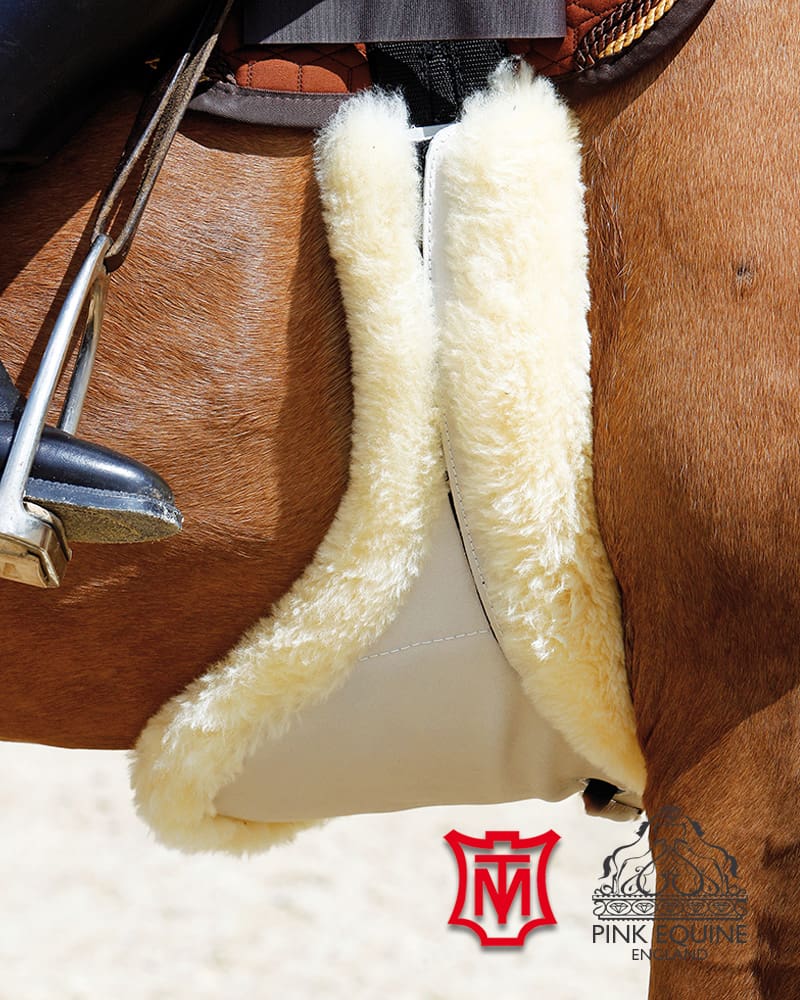
The right girth can transform your horse’s comfort and performance, yet it’s often one of the most misunderstood pieces of tack. For riders who demand both function and finesse, anatomical girths represent a smarter, more sophisticated solution.
Designed to mirror the natural contours of the horse’s body, anatomical girths reduce pressure on the most sensitive such as the elbow and the sternum, allowing for greater freedom of movement and improved saddle stability. But with so many options on the market, girth fit and design should not be underestimated as despite claims, not all anatomical girths are created equal.
In this guide, (part of our Comprehensive Buyer’s Guide to Best Horse Girths series) we’ll explain what truly defines an anatomical girth, why its design matters, and how to choose one that compliments your horse’s conformation. We’ll also introduce two premium options that meet the highest standards of equine ergonomics and craftsmanship: the Pink Equine Ergonomic Girth, and the renowned Mattes range of Anatomical Girths, both trusted by discerning riders across disciplines.
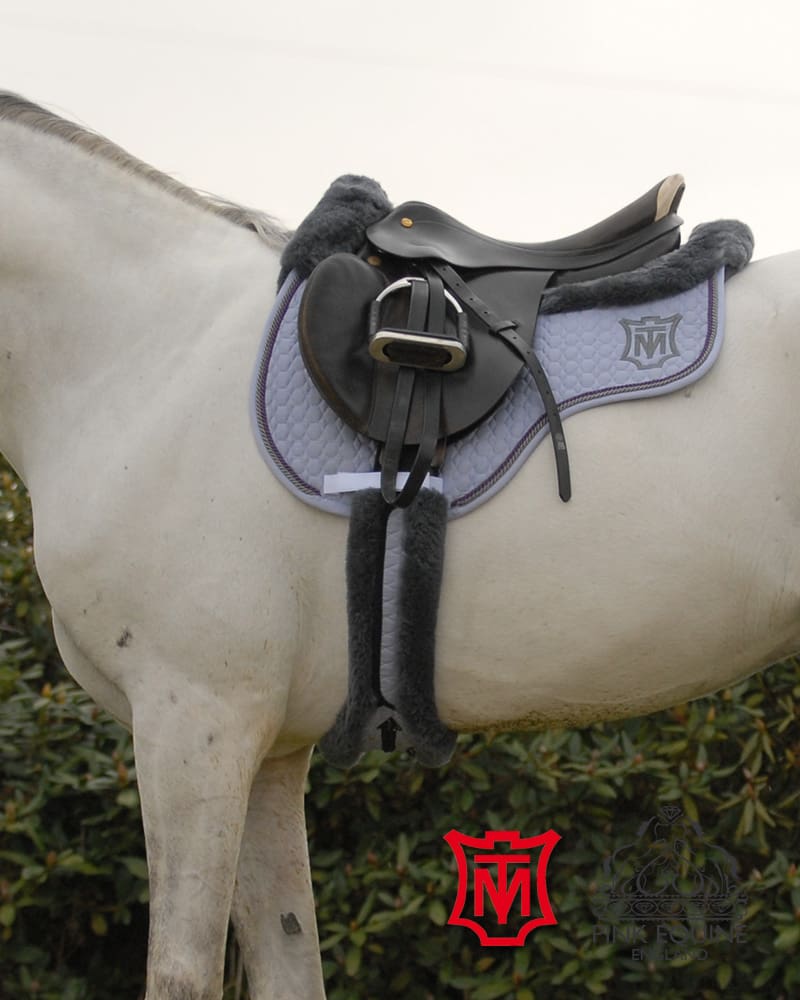
Whether you’re refining your tack for competitive performance or simply want to give your horse the most anatomically considerate equipment available, this article is your starting point.
An anatomical girth is a specially contoured girth designed to follow the natural shape of a horse’s body. Unlike traditional straight girths, anatomical girths are curved to avoid pressure on the most sensitive areas, like the sternum, but especially around the elbow area, allowing for a more comfortable and secure fit.
At its core, the design aims to accommodate the horse’s anatomy, hence the name. The front edge of an anatomical girth typically curves forward to free up space behind the elbows, while the midsection may taper to reduce bulk beneath the ribcage. The result is better saddle stability, improved freedom of movement through the shoulder, and fewer issues with rubbing or resistance.
The term “anatomical” refers to the scientific study of bodily structure, and these girths are engineered with that very principle in mind. By aligning with the horse’s musculature and movement, anatomical girths distribute pressure more evenly, especially during intensive riding or in horses with specific conformation challenges.
This isn’t just a marketing term, it’s a genuine effort to create a more biomechanically sympathetic piece of tack.
Switching from a standard straight girth to an anatomical design can dramatically improve your horse’s comfort, movement, and overall ride quality. Here’s how:
1. Smarter Pressure Distribution
Unlike traditional girths that often press directly on the sternum and behind the elbows, Anatomical girths are engineered to better align with your horse’s body shape, and that includes redistributing pressure away from the most restrictive and sensitive zones.
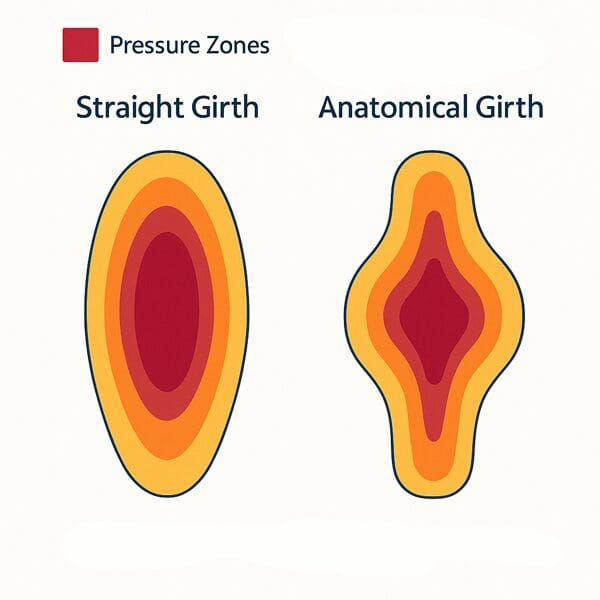
The comparison shows how a traditional straight girth creates intense pressure (red zones) around the sternum and elbow, especially in horses with a forward girth groove. Anatomical girths, while not eliminating pressure, spread the load more evenly, reducing peak discomfort and enabling better freedom of movement.
In fact, a study by Centaur Biometrics found that the highest pressure occurs just behind the elbow, not the sternum. Their research showed that an anatomical girth could reduce this pressure by up to 82%, resulting in a 33% improvement in limb extension and stride.
Key Point: Anatomical girths don’t remove pressure, they relocate and soften it in the areas that matter most for movement and comfort.
2. Improved Anatomical Fit
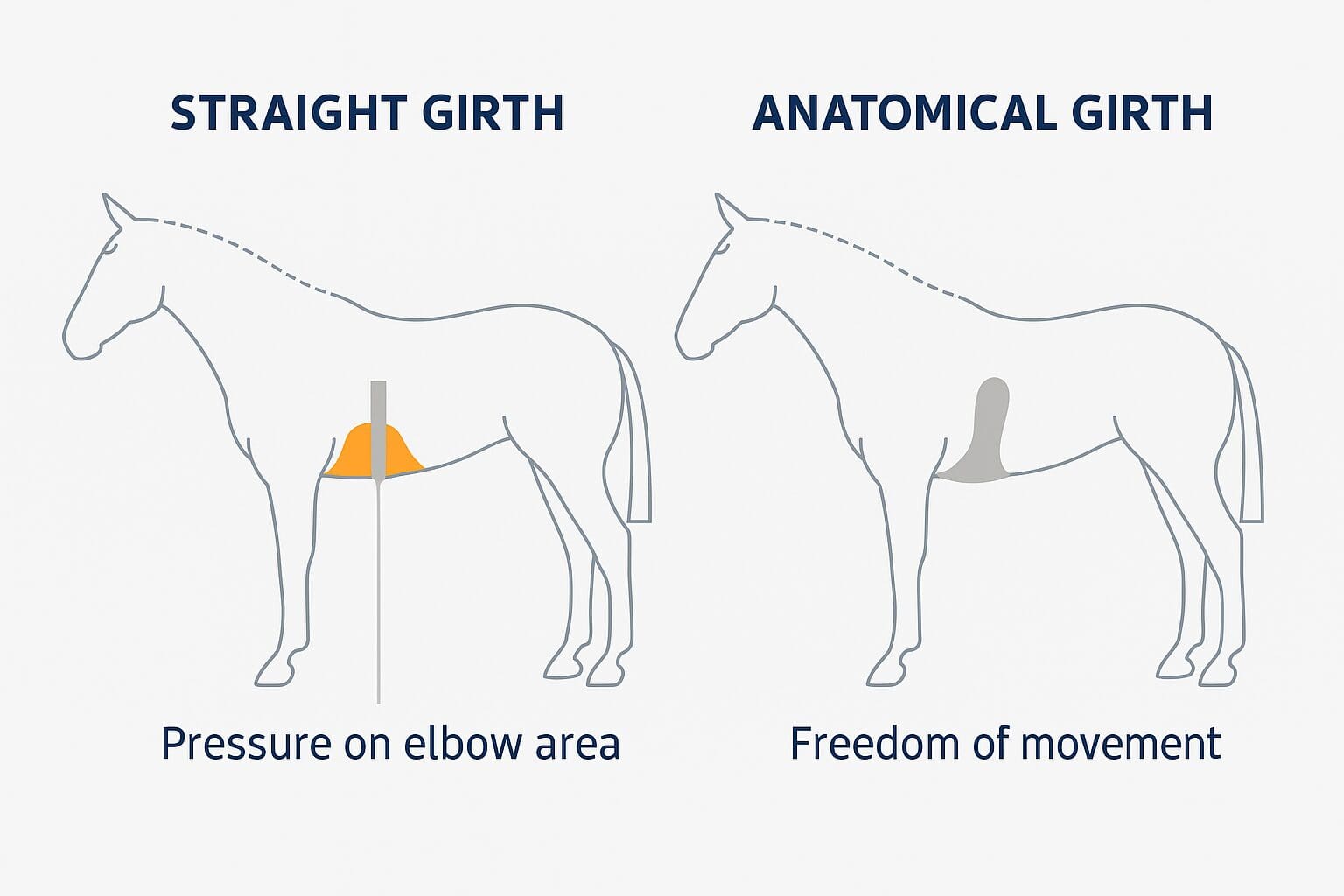
Anatomical girths are precisely shaped to mirror the contour of your horse’s ribcage, particularly where the girth line intersects the natural curve of the body. The curved design allows the girth to sit back behind the elbows, avoiding interference with forelimb movement.
Anatomical Fit Diagram: Side-by-side visuals of a straight vs anatomical girth clearly demonstrate:
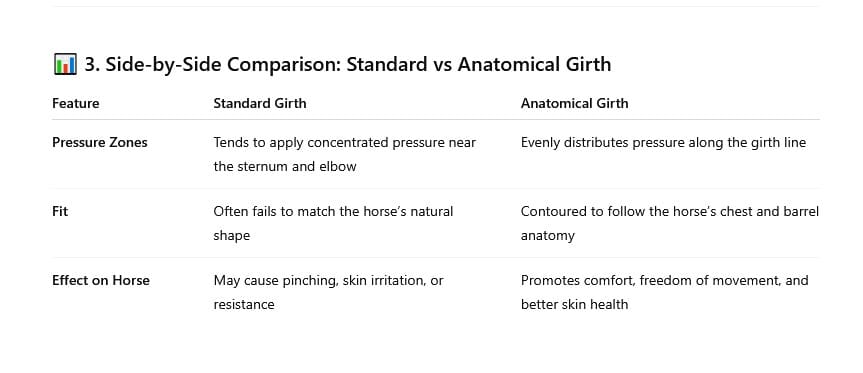
Key Point: Straight Girth: Pulls tightly across the elbows, often causing rubbing, discomfort, or shortness of stride. Anatomical Girth: Gently curves around the barrel, allowing unrestricted movement and a more secure saddle fit. This is especially important for horses with a forward girth groove, a round belly, or those that are particularly sensitive.
Studies found the best anatomical girths that have been correctly fitted resulted in up to 33% improvement in movement patterns. That’s not just comfort — that’s enhanced athleticism.
Correctly fitting an anatomical girth is essential to unlocking its benefits. A poorly positioned or measured girth, even a well-designed one, can cause just as much discomfort as an ill-fitting straight girth — or worse.
This section walks you through how to choose the right size, place it correctly, and avoid common mistakes.
1. How to Measure for the Correct Size
For the most accurate results, always measure your horse after exercise, when the muscles are warmed up and there’s less chance of them “blowing out” or tensing against the girth. Measuring when your horse is relaxed helps ensure a more realistic and reliable fit. Make sure your horse is saddled and the girth is properly fastened on both sides, with the buckles sitting evenly.
For Long Girths:
Using a soft tape measure, run it from the middle hole of one girth billet to the corresponding hole on the opposite side. If your measurement falls between standard girth sizes, always round up to the next available length — a slightly longer girth is preferable to one that’s too tight or restrictive.
For Short Girths:
Using a soft tape measure, measure from the lower edge of the saddle flap on one side, to the same point on the other side, then subtract 30cm. Always round it up to the next length.
Key Points: Ensure that girth buckles (left and right) are equal +- one hole. Make sure that the girth is fitted in relation to the horse’s anatomy. Ensure the girth buckles are up as high as possible – away from the sensitive areas behind the elbows. Anatomical girths often appear longer due to their shape — always measure before purchasing, and don’t assume your current girth length will translate directly.
Pink Equine Girth Sizing Guides
2. Proper Girth Positioning
A correctly fitted anatomical girth should:
Sit behind the elbows, not directly on them.
Allow clear movement of the forelimb without chafing.
Align with your horse’s girth groove, which may be forward, neutral, or backward depending on conformation.
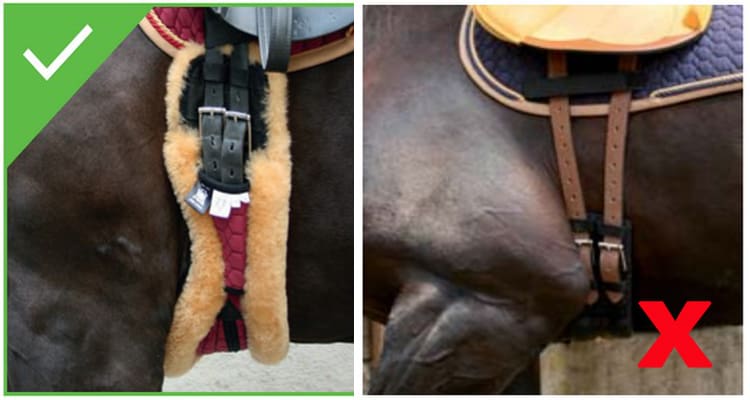
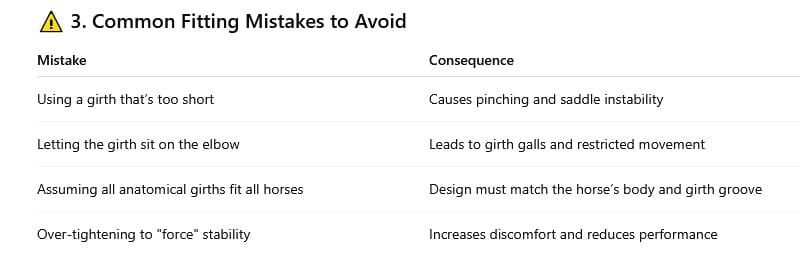
A girth should provide stability, not force it. Let the shape and correct placement do the work. You should not underestimate the effect that girth fit and design can have on your horse’s movement.
As we mentioned in the Introduction “Not all anatomical girths are created equal”. Design, materials, and fit all play critical roles in delivering the comfort, performance, and pressure relief that these girths are known for. Below, we highlight two industry-leading options, Pink Equine and Mattes, that represent the gold standard in ergonomic girth design.
View Pink Equine Ergonomic Girths
Crafted from premium Italian leather and padded with breathable, non-deforming neoprene, this anatomical girth is built for both form and function. The ergonomic cut allows for extra clearance around the elbows, helping to eliminate rubbing and discomfort while supporting natural movement.
Key Features:
Whether you’re training daily or competing at high levels, this girth combines refined aesthetics with ergonomic performance. It’s a perfect choice for horses needing anatomical support without sacrificing traditional leather tack styling.
When it comes to anatomical girths, Mattes is in a class of its own. Developed in collaboration with top European riders, Mattes girths are engineered to solve the most common and frustrating girthing problems. Their strength lies not only in the iconic lambskin lining, but in the sophisticated shape and internal construction that targets pressure distribution where it matters most.
Mattes Girth Designs Explained:
Anatomic – Designed for horses with a standard girth groove; offers general anatomical relief.
Athletico – Ideal for horses whose girth groove runs forward, helping to keep the saddle from slipping backward.
Crescent – Best for round-barrelled horses with no defined girth groove.
Asymmetric – Specifically designed to relieve pressure behind the elbows in horses with strong or forward shoulders.
Each girth contains an internal structure with precision-shaped plastic pressure distribution plates, not only do these prevent pressure from accumulating in any one area, avoiding “hot spots” common in poorly designed girths, but they ensure that the girth retains it shape, unlike many cheaper versions.
Mattes offers their girths in two finishes:
1. Cotton quilt padding: Classic feel with structure.
2. Slimline leather padding: A narrower profile that’s ideal for horses with minimal or no girth groove.
At Pink Equine, we’ve been fitting and recommending Mattes girths for nearly five years, with hundreds of successful customer outcomes. Whether the horse was girthy, prone to saddle slipping, or had an unusual conformation, we’ve used our knowledge and Mattes’ versatile range to find the right solution.
We’re proud to say our success rate stands at over 99%, and that’s precisely why in addition to our own brand, we only work with Mattes. In our view, no other brand offers the combination of design precision, pressure-relieving performance, and material quality that Mattes delivers. They’ve never let us, or our customers down.
A poorly fitted girth causes discomfort on every single stride. That’s why we focus exclusively on anatomical solutions we trust.
To preserve the longevity and performance of your anatomical girth, regular cleaning and proper care are essential. High-quality girths, especially those made from Italian leather or fitted with lambskin, require a bit more attention, but the payoff is lasting comfort, safety, and aesthetics.
Pro Tip: If your girth has neoprene padding, you can clean the underside gently with warm water and a mild, non-detergent soap. Avoid scrubbing aggressively to preserve the integrity of the material.
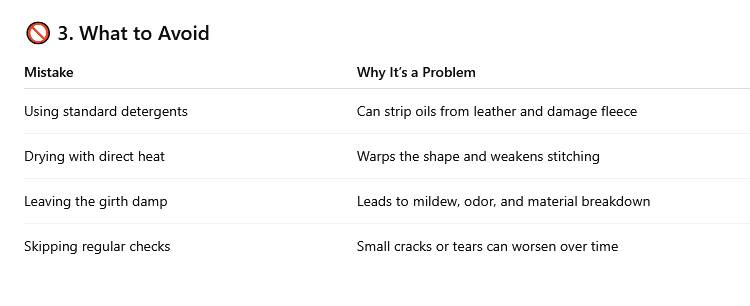
Final Thought: Your girth is one of the most intimate contact points between horse and tack. Treat it with the same care you give your saddle or bridle, and it will reward you with years of safe, comfortable riding.
Choosing the right anatomical girth isn’t just about upgrading your tack, it’s about giving your horse the freedom to move, breathe, and perform without discomfort or restriction.
From Italian leather to high-performance lambskin, anatomical girths are carefully engineered to reduce pressure behind the elbows, prevent rubbing, and improve saddle stability. But as we’ve seen, not all anatomical girths are created equal, the difference lies in the design, fit, and the level of expert support behind the product.
At Pink Equine, we’ve spent years helping riders solve real-world girthing problems, and we’ve seen firsthand the transformation that the right girth can make.
Whether you’re dealing with saddle slip, girth sensitivity, or just want the best fit possible, we’re here to help.
✔ Expert advice from specialists who understand conformation
✔Mattes and Pink Equine products — the best anatomical girths available
✔Custom options tailored to your horse’s shape and your riding discipline
Get personalised advice from a team with a 99% success rate in girth recommendations.
Click here to start your girth fitting consultation
or
Browse our Anatomical Girth Collection
Your horse will feel the difference. So will you.
1. What is the difference between a standard and anatomical girth?
A standard girth is typically straight and applies uniform pressure across the horse’s underside, which can cause discomfort, especially behind the elbows. An anatomical girth is contoured to follow the horse’s natural shape, reducing pressure on sensitive areas and improving freedom of movement.
2. Do anatomical girths really make a difference?
Yes. When correctly fitted, anatomical girths can significantly reduce pressure, improve saddle stability, and enhance your horse’s range of motion. Studies have shown up to a 33% improvement in limb extension when using a properly designed girth.
3. How do I know if my horse needs an anatomical girth?
If your horse shows signs of girth sensitivity, saddle slipping, shortness of stride, or reluctance to move freely, an anatomical girth could help. They’re particularly beneficial for horses with forward girth grooves, strong shoulders, or a round barrel.
4. Are leather anatomical girths better than synthetic ones?
It depends on your priorities. High-quality leather girths like the Pink Equine model offer elegance and durability, while options like Mattes combine ergonomic design with lambskin for ultimate comfort. Fit and shape matter more than material alone.
5. How should I clean my anatomical girth?
For leather girths, wipe down daily and condition regularly. For lambskin girths, use a specialist detergent (like MELP) and always air dry. Never use standard detergents or direct heat, as they can damage the materials.